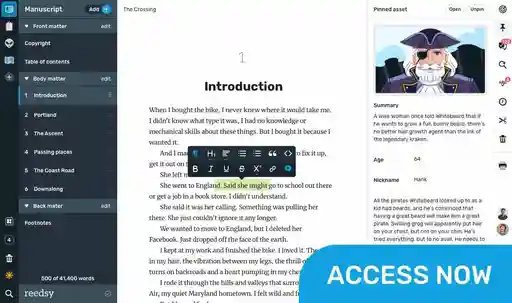Guides • Perfecting your Craft
Last updated on Jul 24, 2023
6 Unbreakable Dialogue Punctuation Rules All Writers Must Know
About the author
Reedsy's editorial team is a diverse group of industry experts devoted to helping authors write and publish beautiful books.
More about the Reedsy Editorial Team →Martin Cavannagh
Head of Content at Reedsy, Martin has spent over eight years helping writers turn their ambitions into reality. As a voice in the indie publishing space, he has written for a number of outlets and spoken at conferences, including the 2024 Writers Summit at the London Book Fair.
View profile →Dialogue punctuation is a critical part of written speech that allows readers to understand when characters start and stop speaking. By following the proper punctuation rules — for example, that punctuation marks almost always fall within the quotation marks — a writer can ensure that their characters’ voices flow off the page with minimal distraction.
This post’ll show you how to format your dialogue to publishing standards.
6 essential dialogue punctuation rules:
- 1. Always put commas and periods inside the quote
- 2. Use double quote marks for dialogue (if you’re in America)
- 3. Start a new paragraph every time the speaker changes
- 4. Use dashes and ellipses to cut sentences off
- 5. Deploy single quote marks used for quotes within dialogue
- 6. Don’t use end quotes between paragraphs of speech
1. Always put commas and periods inside the quote
The misplacement of periods and commas is the most common mistake writers make when punctuating dialogue. But it’s pretty simple, once you get the hang of it. You should always have the period inside the quote when completing a spoken sentence.
Example: “It’s time to pay the piper.”
As you’ll know, the most common way to indicate speech is to write dialogue in quotation marks and attribute it to a speaker with dialogue tags, such as he said, she said, or Margaret replied, or chirped Hiroko. This is what we call “attribution” when you're punctuating dialogue.
Insert a comma inside the quotation marks when the speaker is attributed after the dialogue.
Example: “Come closer so I can see you,” said the old man.
If the speaker is attributed before the dialogue, there is a comma outside the quotation marks.
Example: Aleela whimpered, “I don’t want to. I’m scared.”
If the utterance (to use a fancy linguistics term for dialogue 🤓) ends in a question mark or exclamation point, they would also be placed inside the quotation marks.
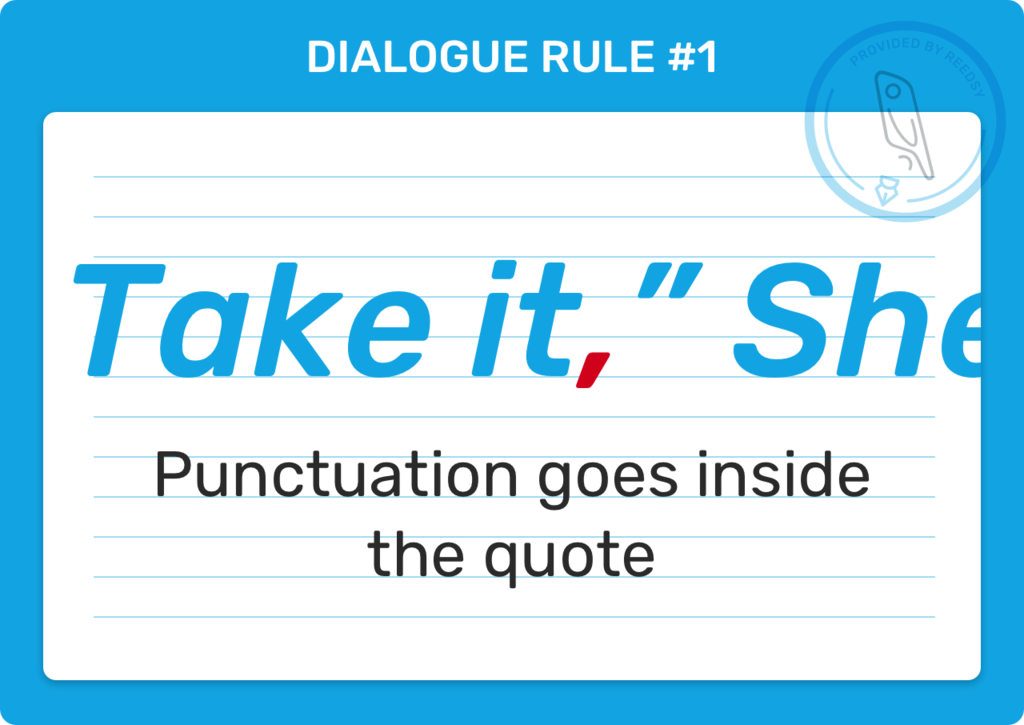
Exception: When it’s not direct dialogue.
You might see editors occasionally place a period outside the quotation marks. In those cases, the period is not used for spoken dialogue but for quoting sentence fragments, or perhaps when styling the title of a short story.
Examples:
Mark’s favorite short story was “The Gift of the Magi”.
My father forced us to go camping, insisting that it would “build character”.
Now that we’ve covered the #1 rule of dialogue punctuation, let’s dig into some of the more nuanced points.
2. Use double quote marks for dialogue (if you’re in America)
In American English, direct speech is normally represented with double quotation marks.
Example: “Hey, Billy! I’m driving to the drug store for a soda and Charleston Chew. Wanna come?” said Chad
In British and Commonwealth English, single quotation marks are the standard.
Example: ‘I say, old bean,’ the wicketkeeper said, ‘Thomas really hit us for six. Let’s pull up stumps and retire to the pavilion for tea.’
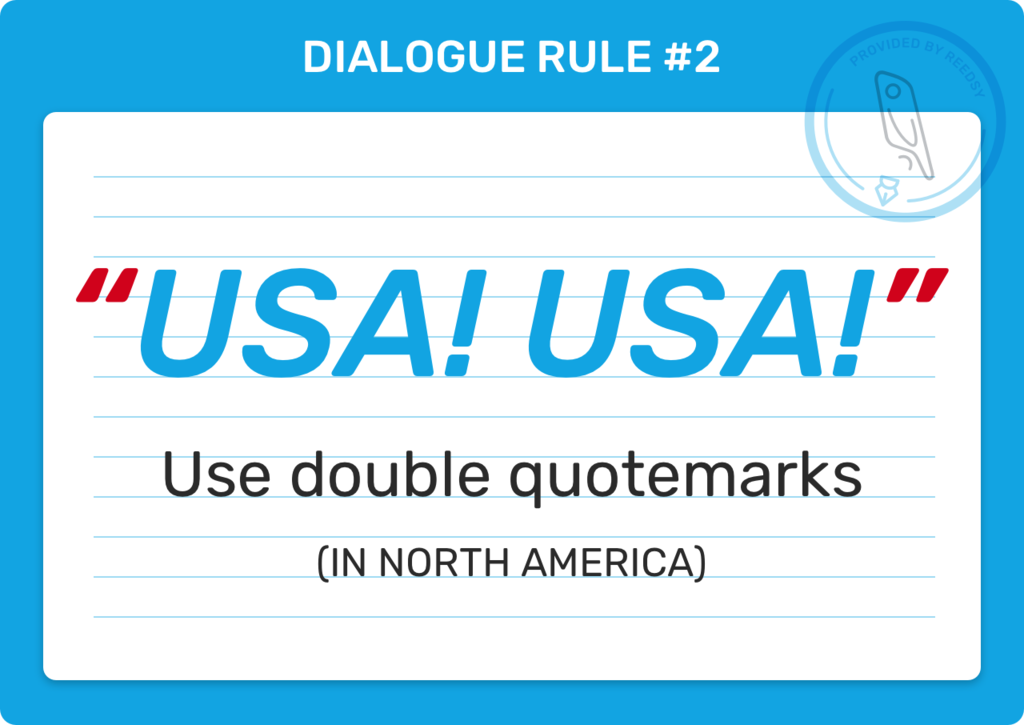 If you’re writing for publication in the United States, refer to the widely accepted standards set by the Chicago Manual of Style. Every editor will know its rules (and many will keep a copy within arm’s reach).
If you’re writing for publication in the United States, refer to the widely accepted standards set by the Chicago Manual of Style. Every editor will know its rules (and many will keep a copy within arm’s reach).
3. Start a new paragraph every time the speaker changes
This is one of the most fundamental rules of organizing dialogue. To make it easier for readers to follow what’s happening, start a new paragraph every time the speaker changes, even if you use dialogue tags.
Example:
“What do you think you’re doing?” asked the policeman.
“Oh, nothing, officer. Just looking for my hat,” I replied.
The new paragraph doesn’t always have to start with direct quotes. Whenever the focus moves from one speaker to the other, that’s when you start a new paragraph. Here’s an alternative to the example above:
“What do you think you’re doing?” asked the policeman.
I scrambled for an answer. “Oh, nothing, officer. Just looking for my hat.”
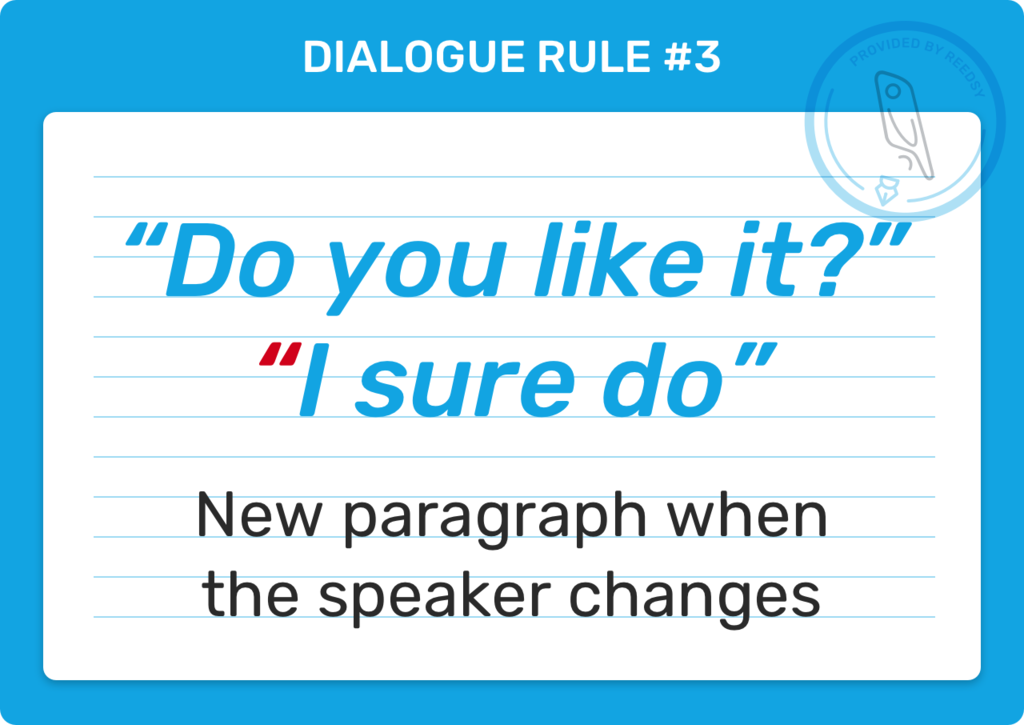 💡Pro tip: Imagine you’re watching the conversation play out in front of you in real life. Every time you feel like you would turn your head and look at a different character, either because they’ve started to speak, or you're anticipating their reply, that’s when you would start a new paragraph.
💡Pro tip: Imagine you’re watching the conversation play out in front of you in real life. Every time you feel like you would turn your head and look at a different character, either because they’ve started to speak, or you're anticipating their reply, that’s when you would start a new paragraph.

FREE COURSE
How to Write Believable Dialogue
Master the art of dialogue in 10 five-minute lessons.
4. Use dashes and ellipses to cut sentences off
So far, all of the examples we’ve shown you are of characters speaking in full, complete sentences. But as we all know, people don’t always get to the end of their thoughts before their either trail off or are interrupted by others. Here’s how you can show that on the page.
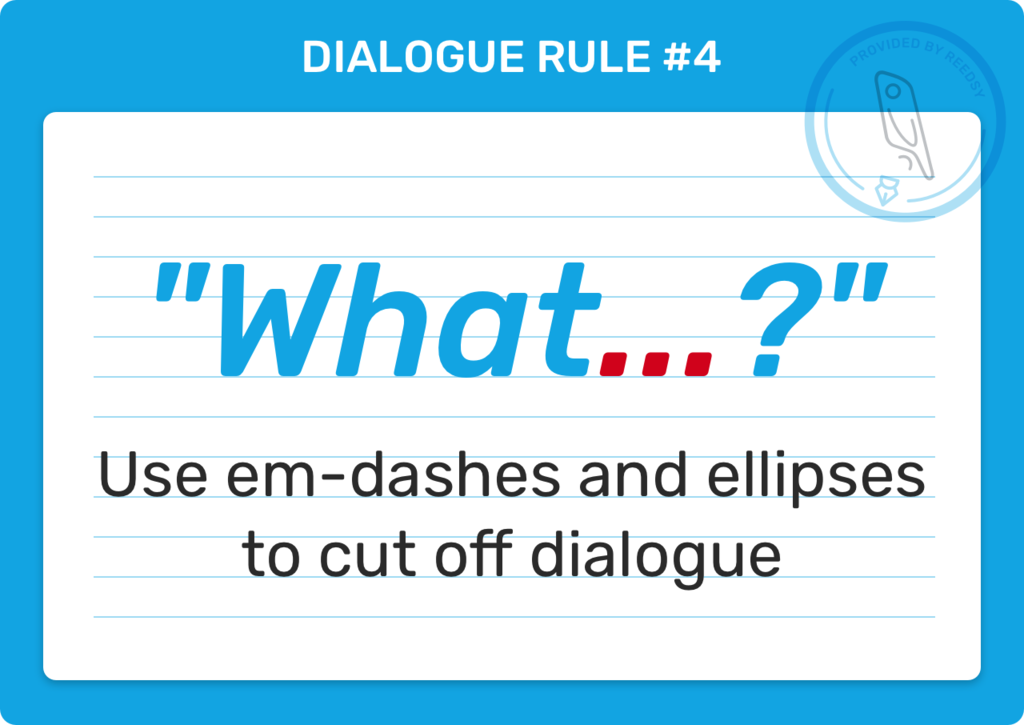
Em-dashes to interrupt
When a speaking character is cut off, either by another person or a sudden event, use an em-dash inside the quotation marks. These are the longest dashes and can be typed by hitting alt-shift-dash on your keyboard (or option-shift-dash for Mac users).
Examples:
“Captain, we only have twenty seconds before—”
A deafening explosion ripped through the ship’s hull. It was already too late.
Or…
“Ali, please tell me what’s going—”
“There’s no use talking!” he barked.
You can also overlap dialogue to show one character speaking over another.
Example:
Mathieu put his feet up as the lecturer continued. "Current estimates indicate that a human mission will land on Mars within the next decade—"
"Fat chance."
"—with colonization efforts following soon thereafter."
Sometime people won’t finish their sentences, and it’s not because they’ve been interrupted. If this is the case, you’ll want to…
Trail off with ellipses
You can indicate the speaker trailing off with ellipses (. . .) inside the quotation marks.
Example:
Velasquez patted each of her pockets. “I swear I had my keys . . .”
Ellipses can also suggest a small pause between two people speaking.
Example:
Dawei was in shock. “I can’t believe it . . .”
“Yeah, me neither,” Lan Lan whispered.
💡Pro tip: The Chicago Manual of Style requires a space between each period of the ellipses. Most word processors will automatically detect the dot-dot-dot and re-style them for you — but if you want to be exact, manually enter the spaces in between the three periods.
5. Deploy single quote marks used for quotes within dialogue
In the course of natural speech, people will often directly quote what other people have said. If this is the case, use single quotation marks within the doubles and follow the usual rules of punctuating dialogue.
Example:
“What did Randy say to you?” Beattie asked.
“He told me, ‘I got a surprise for you,’ and then he life. Strange, huh?”
But what if a character is quoting another person, who is also quoting another person? In complex cases like this (which thankfully aren’t that common), you will alternate double quotation marks with single quotes.
Example:
“I asked Gennadi if he thinks I’m getting the promotion and he said, ‘The boss pulled me aside and asked, “Is Sergei going planning to stay on next year?”’”
The punctuation at the end is a double quote mark, followed by a single quote mark, followed by another double quote. It closes off:
- What the boss said,
- What Gennadi said, and
- What Sergei, the speaker, said.
Quoting quotes within quotes can get messy, so consider focusing on indirect speech. Simply relate the gist of what someone said:
“I pressed Gennadi on my promotion. He said the boss pulled him aside and asked him if I was leaving next year.”
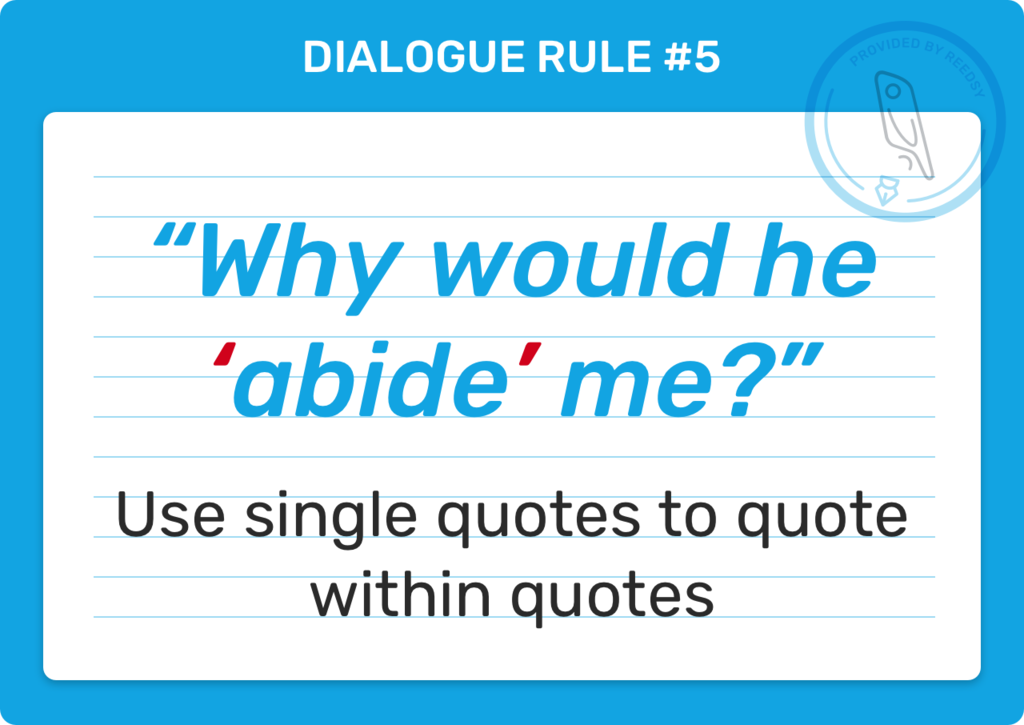 So far, all our examples are for short sharp bursts of dialogue. But what happens when our characters start monologuing?
So far, all our examples are for short sharp bursts of dialogue. But what happens when our characters start monologuing?
6. Don’t use end quotes between paragraphs of speech
In all the examples above, each character has said fewer than 10 or 20 words at a time. But if a character speaks more than a few sentences at a time, to deliver a speech for example, you can split their speech into multiple paragraphs. To do this:
- Start each subsequent paragraph with an opening quotation mark; and
- ONLY use a closing quotation mark on the final paragraph.
Example:
"Would you like to hear my plan?" the professor said, lighting his oak pipe with a match. "The first stage involves undermining the dean's credibility: a small student protesst here, a little harassment rumor there. It all starts to add up.
"Stage two involves the board of trustees, with whom I've been ingratiating myself for the past two semesters."
Notice how the first paragraph doesn't end with an end quote? This indicates that the same person is speaking in the next paragraph. You can always break up any extended speech with action beats to avoid pages and pages of uninterrupted monologue.
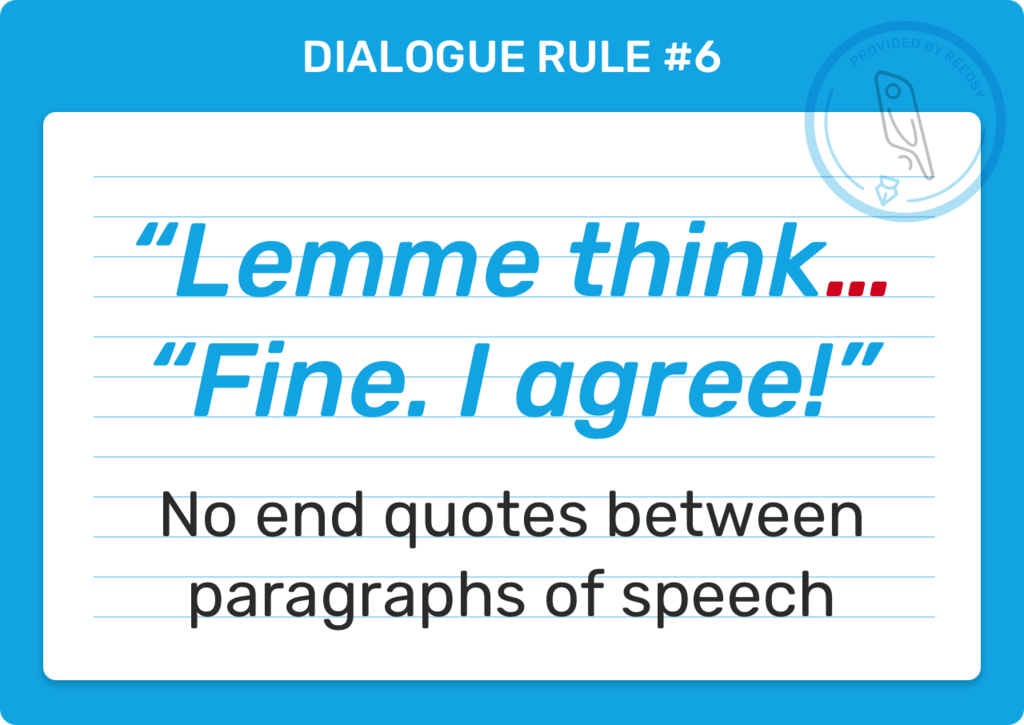
Want to see a great example of action beats breaking up a monologue? Check out this example from Sherlock Holmes.
Hopefully, these guidelines have clarified a few things about punctuating dialogue. In the next parts of this guide, you’ll see these rules in action as we dive into dialogue tags and look at some more dialogue examples here.
